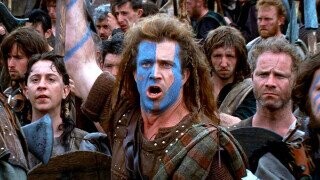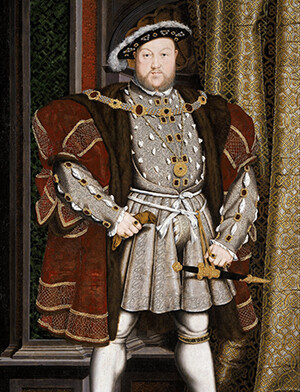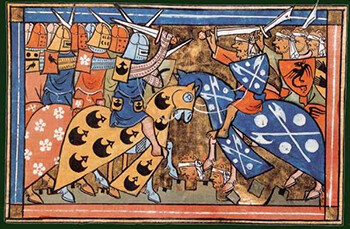18 Medieval Myths You Believe Because Of Movies

Ah, the Middle Ages. Grab your mead and your large joint of meat (not turkey) and get ready to sing some bawdy songs and maybe duck a Viking pillaging. The idea of this 1,000-year time period is often explored in film with epics, comedies, musicals, and whatever A Knight's Tale was. But a lot of the standards you've seen, including virtuous knights, filthy illiterate peasants, and general misery, are pretty warped stereotypes that range from simply inaccurate to downright harmful.
Sure, some knights were probably chill, and plenty of people were and continue to be dirty and sad, but there's a lot more nuance in this fascinating time period than you might think, but movies still like to get things all kinds of wrong, from the large-scale to the small ...
Myth: It Was Only, Like, A Hundred Years
The Middle Ages, or medieval period, was a really, really long time. About a thousand years from the Roman Empire's fall in Western Europe around the mid-400s or 500 to the beginning of the Renaissance or Early Modern period in Italy around 1500. That's a long time -- a thousand years, in fact -- enough for the Middle Ages to be divided into Early, High, and Late periods and to have significant cultural evolutions within the general time period.
Myth: It Was Only In Europe, And Everyone Was White
Movies set in 500 to 1500 are overwhelmingly based in Europe and feature all or almost all-white casts, but obviously, lots of things were going on worldwide. This time period included the fascinating Heian Period in Japan and the Islamic Golden Age in the Middle East and North Africa. It was also when the African empires of Mali and Benin got their start, which would become some of the richest kingdoms in the world, holding records to this very day.

National Library of France
In the Americas, the Inca Empire was getting started, and the Maya had been established for nearly a thousand years. In what would become New Mexico, the Taos Pueblo was built and still stands and remains occupied today. Even in Europe, it would not be uncommon to see different people from different places, especially in the larger cities, as trade routes expanded and travel became easier. Actual art from the period itself also reflects its diversity.
Myth: Nothing Happened
People like to call the Middle Ages the "Dark Ages" because of the belief that all things cultural came to a screeching halt with the decline of the Roman Empire in Western Europe. But that's not accurate. For one thing, a lot of things happen over 1,000 years and within multiple cultures. The term "Dark Ages" was first described by Italian writer Petrarch in 1343, who saw the ages of the Greeks and Romans as great, and the time he was living in as bad, and the phrase itself was coined in 1602. And for some reason, this myopic idea stuck around. In fact, the very idea of the Middle Ages followed by the Renaissance came from Petrarch.
But there were actually several "renaissances" in the Middle Ages, such as the Carolingian Renaissance and the 12th Century Renaissance when art and science flourished.
Myth: People Only Lived To Be 30
So, this one is and isn't true. The idea of life expectancy being only 30 is really a misunderstanding of how life expectancy works. You will, in fact, see that the average life expectancy is about 30 if you look this up, but remember: that's factoring in infant mortality rates, which were high, as well as childhood mortality rates, which were also high. Include all those low numbers, and your average will be low. However, people who survived childhood could often expect to live well into their 60s and even 70s.

Myth: People Were Really Stupid
Okay, well, they probably were … but human stupidity is hardly limited to these times. The Middle Ages gets slammed for being backward, oppressive, and violent, and to be clear, it was in a lot of ways, but again, that's nothing new (or old). In other ways, scholastic endeavors really took off during this time in both the European and Islamic worlds. People studied math, astronomy, architecture, literature, and alchemy, which would later evolve into chemistry. Many European universities were founded during this time, some of which are still operational, and many people, including women, were literate. However, formally educated people would have been overwhelmingly male and from families of means. Monasteries were also centers of learning but focused on liturgy and prayer.
Myth: The Church Always Suppressed Science
In the Middle Ages, the divide between religion and science wasn't as pronounced as it might seem in later eras. In fact, many scholars and scientists of the era were also monks or otherwise religious people. Historian David Lindberg argues that "the late medieval scholar rarely experienced the coercive power of the Church and would have regarded himself as free (particularly in the natural sciences) to follow reason and observation wherever they led." The cultural division of religion and science didn't really happen until the Enlightenment Age of the 17th and 18th centuries; before that, science and religion were considered to exist simultaneously and even be the same thing. Also, the church didn't forbid autopsies and dissections, either.
Myth: Everybody Thought The Earth Was Flat
People have known the Earth is a sphere for a long time. In the Middle Ages, scholars from all over depicted the planet as round and could even calculate its approximate circumference. While models depicting a flat Earth did exist in ancient times, by the Middle Ages in Europe, people had abandoned that idea in favor of a spherical model. Kings of the period used an orb, held in the left hand, to signify their dominion over the world. The idea that everyone thought the Earth was flat only started appearing in the 19th century, when people were into the idea that the church hated science, and still persists today.

Myth: Battles Were Super Epic With Lots of Matching Uniforms And Great Speeches Beforehand
These kinds of battlefield spectacles show up in movies a lot, in everything from Braveheart to Lord of the Rings, because matching uniforms are both visually appealing and serve and shorthand for who is who, and epic speeches to rile up the troops are fun and exciting. But realistically, this didn't happen. For one thing, do you really think one shouting guy could be heard all the way in the back? Probably not.

Paramount Pictures
Also, you know, there was an enemy army bearing down on you. Furthermore, battles and sieges lasted a long time and were rarely the one-and-done battles you see in film. But hey, movies have a time limit.
Myth: Burning Witches Was A General Pastime
Unfortunately, women (as well as men) were persecuted for witchcraft across Europe and in the colonial Americas, resulting in mass hysterias and senseless deaths, mostly of older women. But it didn't happen during the Middle Ages. Widespread witch-hunting reached its peak in the 16th and 17th centuries, and hanging was the most common form of execution during those times. In the Middle Ages, the church taught that witches didn't even exist and would get annoyed if you suggested they did.
Myth: Everyone Was Really Dirty All The Time
While hygiene standards of the Middle Ages would certainly not be up to ours today, people did not actually walk around covered in literal shit. However, movies love to slap their actors with black greasepaint and have them wallow in filth as though wiping one's face (or other parts) had yet to be invented. But people were largely much cleaner than they get credit for. For one thing, smelling bad was associated with sin, so people tried to smell as fresh as possible and were encouraged to bathe. Public saunas and bathhouses were popular with all social strata (the city of Bath in England is named for its natural hot springs), and even the poorest people could bathe with washcloths or in rivers. Soap, which was invented in the Middle East, was brought back by returning Crusaders, which allowed people to get even cleaner.

Via Medievalists.net
Myth: The Streets Were Just As Dirty As The People
Nothing defines a movie set in the Middle Ages like a muddy, nasty street full of chickens and human waste and maybe a donkey who's just kind of around, but that's not exactly accurate, either. There were laws in place that required people to keep the area around their homes and shops clear, and fines were in place for littering. People could also be fined for letting their animals roam in the streets unattended. As for the human waste part, public latrines were available, and muck-rakers were hired to sweep the streets clear of other waste -- and paid pretty well for their gross job. Other public rules included not being allowed to slaughter animals in the street, as well as fines for fighting and playing tennis in the streets.
Myth: Everyone Ate Really Big Turkey Legs
The Big Turkey Leg is a standard of Renaissance Faires, and that actually is more accurate. See, turkeys are from the Americas and didn't appear in European cuisine until the 16th century, placing them squarely in the Renaissance. Even so, dining scenes in Medieval movies often feature some kind of big drumstick being eaten, often sloppily. If a big bird was being eaten, you'd more likely see a smaller goose or a swan drumstick on the table, or even a peacock. You also wouldn't see potatoes, which are also native to the Americas but show up as a staple crop in Middle Age European settings.

Myth: Everyone’s Clothing Had Metal Eyelets
Okay, this one might be a nitpick, but once you see it, you'll never unsee it. When it comes to costuming, movies set in the medieval period like to go wild with lacing. You'll see it on pretty much every garment and every gender, and you might notice that the laces are being fed through holes with little metal rings in them -- Metal rings that would not be invented until the 19th century. While medieval clothing often featured lacing, which was used to get a better fit, the holes would have just been reinforced with thread, like a buttonhole. But modern costume designers seemed to have all missed that memo, and you'll see metal eyelets twinkling all over movie outfits.
Myth: Flowing Hair Everywhere
Movies love to show off lots of shiny, flowing hair for their female leads because hair is pretty and fits well with modern styles. But realistically, women and girls did not walk around with their hair loose. For one thing, that would have been considered immodest, and modesty was a big deal. Hair would have been braided and wrapped or pinned up and often covered with a cloth headdress. This was especially true for married women. Unmarried women and girls might let their hair be a little looser, but women bound up and covered their hair once married.

Myth: You Can Just Slice Through Plate Armor, It's Fine
What's the point of wearing armor if a dude is going to slice right through it with a sword or puncture it with an arrow? Well, it makes for a great action scene. But no one would bother wearing armor in real life if it was as ineffective as it appears in film. Metal armor, including both plate and chain mail, is actually really good at repelling sword blows. To injure or kill someone wearing armor, you would have to aim for the gaps where the plates met or for a place where there was no armor. Real armor was, above all, practical, and did in fact, protect the people inside, at least until the invention of firearms.
Myth: Chivalry Means Kissing Hands
It's just not a Middle Ages movie without a guy slobbering all over some noblewoman's hand. Kissing a lady's hand has become the move if you want to brand yourself a chivalrous gentlesir. But in the Middle Ages, it would have been seen as super creepy and inappropriate. Kind of like it is now, actually. Putting your lips on a member of the fairer sex who wasn't your spouse or family was simply not done, and certainly not to someone of a higher social status. Hand-kissing didn't become popular until the 18th century, and frankly, we're all glad it went away.
Myth: Chivalry In General
Codes of chivalry existed in the Middle Ages, but they weren't the way we imagine them today, with a focus on protecting the swooning fairer sex and holding doors (with the implication that this will get you laid). No. Chivalry was actually more focused on being merciful, humble, and charitable and was a code of behavior pressed on knights to remind them that, as people with certain class privilege, they should not take advantage of the less fortunate. And this came about because knights, who were very young men with very big swords, were wont to wreak havoc on villages when bored. Even the Crusades seem to be invented to get the jerks out and give them something to do.

Interestingly, the idea of "chivalry" as pertaining to rigid gender roles crops up a lot during times of women's rights movements, including during the Suffragist movements of the 19th and early 20th centuries. Chivalry has come under criticism even at the time, including by Petrarch and Cervantes, and historians have also argued that chivalry was never a monolithic code.
Myth: That Anyone Looked Like Mel Gibson In Braveheart
This movie is full of historical inaccuracies, including its main visual. Gibson's portrayal of William Wallace, who lived in the late 1200s, is anachronistic both coming and going. He wears a kilt (incorrectly), which would not be popular dress attire in Scotland until the 1700s, and woad face paint, which people in Scotland stopped wearing in the 200s. However, the iconic face-paint-and-kilt getup has become a mainstay and often surfaces when we imagine the Middle Ages. The movie is also full of mullets, which might actually have a longer, more storied history than we like to think.
Top image: Via Wikimedia Commons